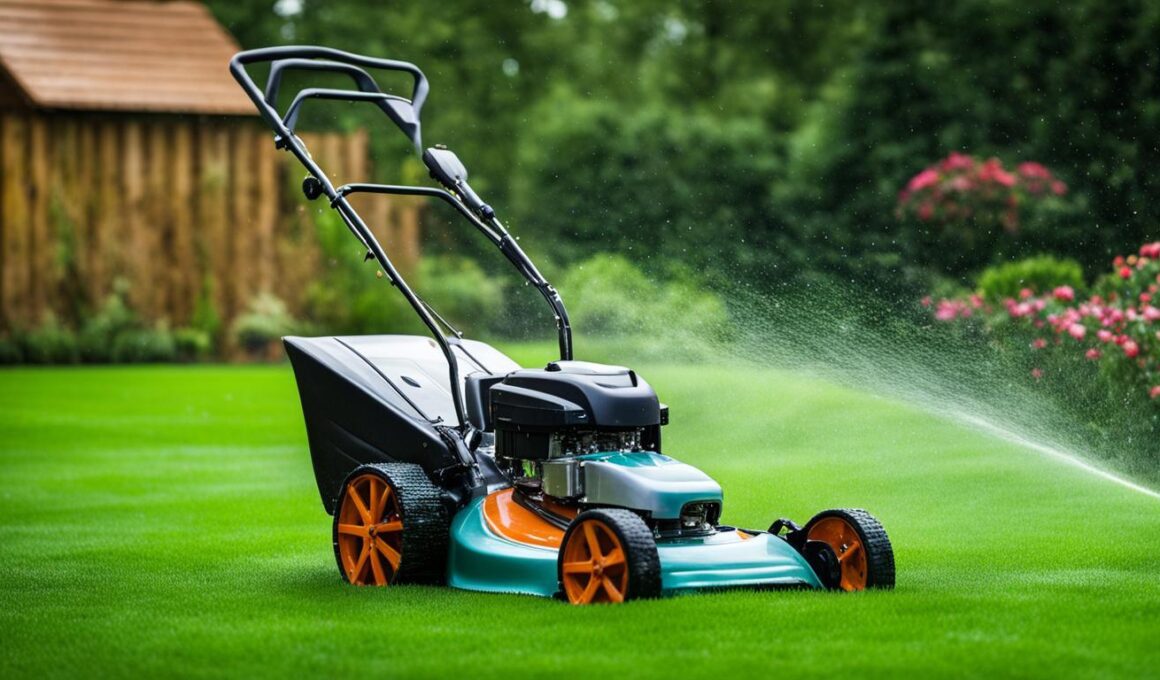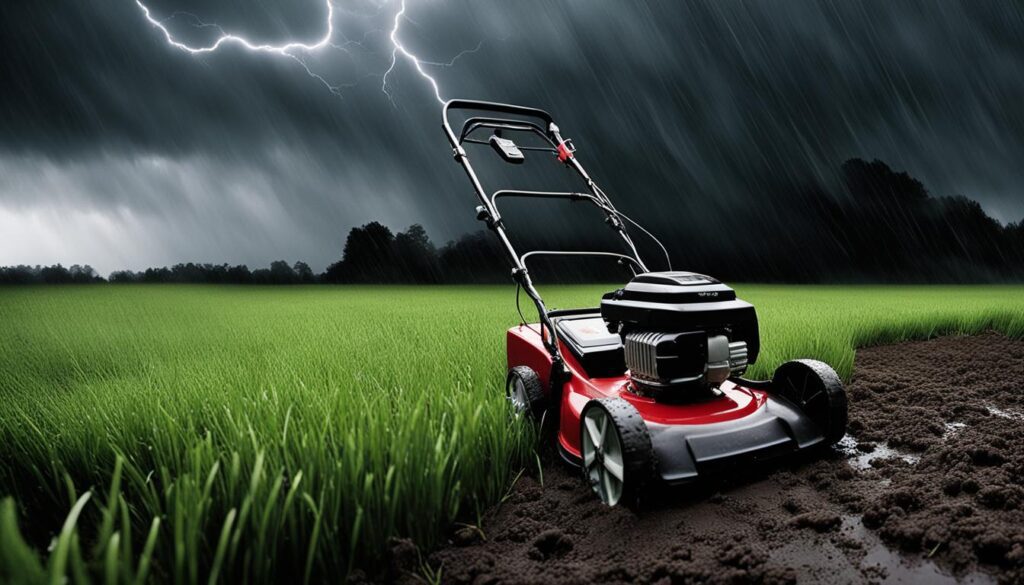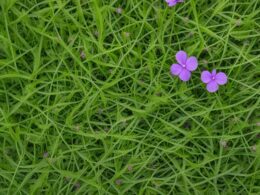Are you wondering whether it’s safe to cut wet grass? Worried about the potential damage it may cause to your lawn? We understand your concerns. Mowing wet grass can be a tricky task, but with the right knowledge and precautions, you can maintain a healthy lawn even when the grass is wet.
Cutting wet grass requires a different approach and careful attention to detail. While it’s generally recommended to wait for the grass to dry after heavy rain, mowing when the grass is wet from dew is generally safe. By following a few essential mowing tips, you can minimize the risks and protect your lawn from potential damage.
Is It Safe to Cut Wet Grass?
While cutting wet grass is generally discouraged due to its potential negative effects on your lawn and safety hazards, there are ways to mitigate the risks and safely mow wet grass. Wet grass can make the surface slippery, increasing the risk of falling and injuring yourself. It can also make it more challenging to control your lawn mower, especially on sloped or uneven terrain, which increases the risk of accidents. However, if you must mow wet grass, it is crucial to take safety precautions, including wearing appropriate footwear with good traction, using a mower with stability and traction, mowing at a slower speed, and avoiding sharp turns or sudden movements.
The Dangers of Mowing Wet Grass
Mowing wet grass can pose several dangers and potential damage to your lawn mower. Wet grass can be slippery, increasing the risk of slipping and falling while mowing. It can also make it more challenging to control the lawn mower, especially on sloped or uneven terrain, leading to a higher risk of accidents. Wet grass clippings can accumulate on the underside of your mower, clogging the blades and restricting movement, potentially damaging the engine.
Moreover, wet grass clippings can spread disease and weeds, leading to the growth of lawn diseases such as brown patch, leaf spot, powdery mildew, and red thread. Mowing wet grass can also result in uneven and unattractive cuts, as well as damage the grass blades and impede proper growth.
Tips for Cutting Wet Grass Safely
When you have no choice but to cut wet grass, there are several tips to follow to minimize the risks and protect your lawn. Before mowing, test the soil moisture to determine if it is too muddy or saturated, as these conditions can cause more harm than good. If the soil is still fairly solid and the grass is just slightly moist, you can try removing excess water by dragging a hosepipe horizontally over your lawn.
It is essential to prepare your mower by ensuring the blades are sharp and adjusting them to the highest setting to reduce strain and achieve a neater cut. When mowing wet grass, start with a small row and go slowly, paying attention to your mower’s sound to avoid overheating. Empty the grass collector frequently to prevent clogging, and clean your lawn mower properly after use to remove wet grass clippings that can accumulate and cause damage.
Remember, cutting wet grass can be tricky and potentially damaging, so it’s important to take extra precautions to ensure a safe and effective mowing experience. By following these tips, you can minimize the risks and protect the overall health and appearance of your lawn.
The Effects of Mowing Wet Grass on Your Lawn
Mowing wet grass can have various negative effects on your lawn. Wet grass clippings can accumulate and suffocate the lawn, blocking air and nutrients from reaching the soil. This can result in uneven or poor growth and make the grass more susceptible to disease. Additionally, wet grass clumps can sit on the lawn and build up mold and fungus, which can be spread during the next mowing. Mowing wet grass can also lead to an uneven and unattractive cut, damaging the grass blades and causing stress to your lawn.
Proper cleanup is essential after mowing wet grass to remove clippings and prevent the undercarriage of your mower from becoming a breeding ground for mold.
Tips for Successfully Cutting Wet Grass
If you find yourself needing to mow wet grass, there are several tips that can help you achieve success while minimizing potential damage. Remember to prioritize safety and take the necessary precautions to protect yourself and your lawn.
One important tip is to spray silicone lubricant on the undercarriage of your mower before mowing. This will prevent damp grass clippings from sticking, allowing for smoother, more efficient cutting.
Another crucial aspect is regularly checking and sharpening the blades of your mower. Sharp blades ensure clean cuts and reduce the strain on both the grass and the mower.
Using a fuel stabilizer and keeping the air filter clean and dry are also essential. These measures help prevent engine performance issues that can arise from mowing wet grass.
Consider using side discharge instead of mulching or bagging wet grass clippings. This can improve the flow of clippings and minimize clogging.
Raising the mower deck and cutting at a slower pace compared to mowing dry grass is recommended. These adjustments help avoid clogging and achieve a neater cut.
Additionally, mowing wet grass on a regular basis is beneficial, especially during the wet season when grass tends to grow faster. Keeping up with regular maintenance and cutting can contribute to a healthier lawn overall.
Remember to prioritize safety, follow these tips, and adapt them to your specific lawn conditions when cutting wet grass.
Continue to the next section for a closer look at the effects of mowing wet grass on your lawn.
Should I Mow My Lawn When It’s Wet and Use the Grass Clippings as Mulch?
Mowing your lawn when it’s wet can lead to a messy, uneven cut, and the wet clippings can clump together, preventing airflow to your grass. However, using grass clippings as mulch when dry can provide nutrients and organic matter for a healthier lawn. Follow these green lawn care tips for best results.
Conclusion
Cutting wet grass can be detrimental to the health and appearance of your lawn. It is generally discouraged due to the potential risks and negative effects it can have on your lawn. However, if you find yourself in a situation where you must mow wet grass, there are several precautions and tips you can follow to minimize damage and protect your lawn and mower.
Firstly, it is essential to test the soil moisture before mowing. If the soil is too muddy or saturated, it is best to wait for it to dry out a bit before attempting to mow. Additionally, removing excess water by dragging a hosepipe horizontally over your lawn can help reduce moisture levels.
Preparing your mower is also crucial when cutting wet grass. Ensuring that the blades are sharp and adjusting them to the highest setting can help reduce strain and achieve a neater cut. Mowing at a slower speed and avoiding sharp turns or sudden movements can help maintain stability and prevent accidents.
Finally, emptying the grass collector frequently and cleaning your lawn mower properly after use are essential steps to prevent the accumulation of wet grass clippings, which can clog the blades and restrict movement. Regular maintenance and cleanup are critical for preserving the health and appearance of your lawn.











